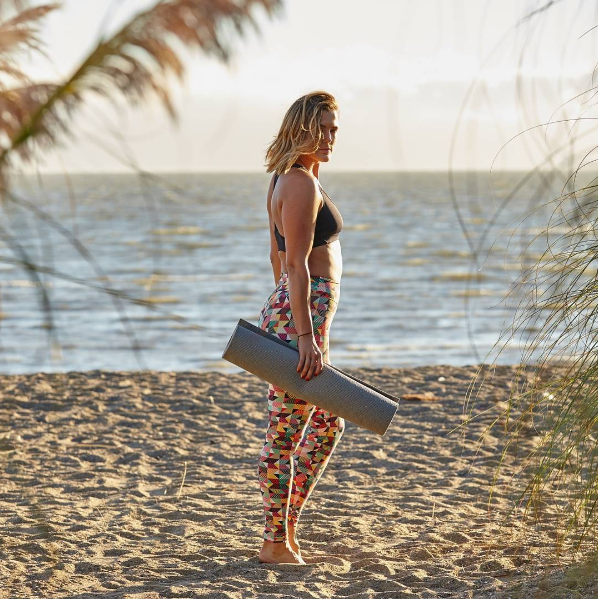
Firm muscles. Fit bodies. Svelte silhouettes. All beautifully shaped by debonair activewear. Are people getting more fit or is it just me?
The booming activewear market is a direct reflection of a growing trend in contemporary society towards the attainment of optimal health and wellness. Over the past year, the general apparel market grew just 1 percent. Meanwhile, the activewear market grew an astounding 7 percent over that same period of time. The activewear (or athletic wear) market is increasing. Why?
Reason 1) Humans Have More Time to be Active. Increasing socioeconomic status around the world gives us more time to work out and look good. We have taken care of the base survival needs at the bottom of Maslow’s Pyramid. For the most part, the civilized world no longer has to worry about basic needs such as food, water, and shelter. We can, instead, dedicate more time to self-actualization, which includes pursuits of self-perfection, like mental growth, physical exercise, and attainment of ideal body image.
Reason 2) Increasing Fitness Culture. We know that exercise is beneficial for us - medical and anecdotal evidence has supported this for decades now - but finally, we have a variety of options catered to our fitness needs. Within a 5 mile radius of your home, you’re likely to find a traditional gym, CrossFit class, dance class or yoga class, probably all four. On social media, you’re likely to spot images of men and women with fit bodies, wearing the latest running shoes or yoga tights. All this is indicative of a global level of fitness never before seen in human history.
Sweat, Baby Sweat
Small wonder an article by Bloomberg found that activewear sales increased by 16 percent from 2014 to 2015. Compare this to a paltry 2 percent year-over-year rise in total apparel sales, and you can clearly spot evidence in support of a growing fitness culture. Regular members of health clubs and fitness classes are upgrading their clothes and workout gear with advanced technology like sweat-wicking materials and cooling fabrics that allow breathability. Athletes that already look good are taking it to the next level with form-fitting clothes made of spandex and Lycra that accentuate the human physique.
Don’t Sweat (But Still Look Like You Came From the Gym)
Keep in mind that sales of athletic wear are not indicative of athletic activity. The people purchasing these “athleisure” (a compound term of “athletic” and “leisure”) are not always working out. However, the fitness culture has increased to a level where individuals want to look and feel as though they are. Men still want to feel masculine as they run chores in muscle tanks. Women still want to look their best in a pair of form-fitting leggings or a cute compression top as they go shopping or meet with friends in the city.
All in all, the main reasons the activewear market is booming is because we have more financial resources to dedicate to looking good, greater availability of clothes and styles, and perhaps an increased pressure from our social group to exercise (or at least look like we do). Others say this trend is due to the extensive reach of social media, and the increased vanity in contemporary society. We are, after all, taking more selfies than ever before. But it may also have something to do with a psychological process recently uncovered by researchers Adam and Galinsky.
The Old Maxim Holds True: ‘You Are What You Wear’
Adam and Galinsky’s paper discusses the idea that clothes have a measurable psychological influence on the person wearing them, influencing the way we think and act. Clothes have symbolic meanings attached to them and impart to the wearer a physical experience that can positively influence mood and behavior. The process discovered by Adam and Galinsky, named “enclothed cognition” was discovered when an experimental group of participants who wore white lab coats were found to be more careful and attentive than participants not wearing a lab coat. (A lab coat is generally associated with carefulness and attentiveness).
Wear a Labcoat, Be Smarter
It’s hard to believe that an individual can do better on detail-oriented task simply by wearing a lab coat, but this is just what the researchers found. Individuals who wore lab coats had higher levels of selective attention compared to individuals who wore normal clothes.
“The clothes we wear have power not only over others, but also over ourselves,” found the researchers. Clothes contribute identity by making the individual embody the clothing and its symbolic meaning. They help us feel more in the mood when it comes to engaging, following, and committing to a behavior as advocated by what the clothing represents. Similarly, a recent article from the New York Times found that “compression clothing may assist athletic performance and recovery in given situations.”
Dress Fit To Be Fit
The conclusion to be drawn is that one must dress the part depending on the activity. You wouldn’t get married in ragged clothes. You wouldn’t go to work in your pajamas or expect to be taken seriously as a police officer if you were not wearing uniform.
Dress the part in all areas of your life.
Perhaps the old maxim holds true: “If you look good, you’ll feel good too.”
Fashion Affects Fitness
Perhaps this is the main reason activewear has been so popular as it is now - because it synthesizes with the activity of fitness. When you tie on a pair of soccer cleats to your feet, you are getting ready to play soccer. Other tasks of the day are left behind and you are more clearly able to focus on the task at hand. When you throw on a sleeveless tank, you are getting ready for weight training. You’re preparing to admire yourself on arm day and have a higher chance of going to the gym in order to fulfill that promise to yourself. When you are slipping into a pair of form-fitting yoga leggings, you’re telling your body and your mind that you’re ready to sweat it out, and tune in during hot vinyasa flow.
Motivation Is up to You!
That being said, enclothed cognition isn't a substitute for intrinsic motivation. The biggest ally you have in this is yourself. We can’t all look like we’re chiseled out of marble, but the way we dress can give us that motivating edge to get out butt into the gym and work towards a better, healthier body.
